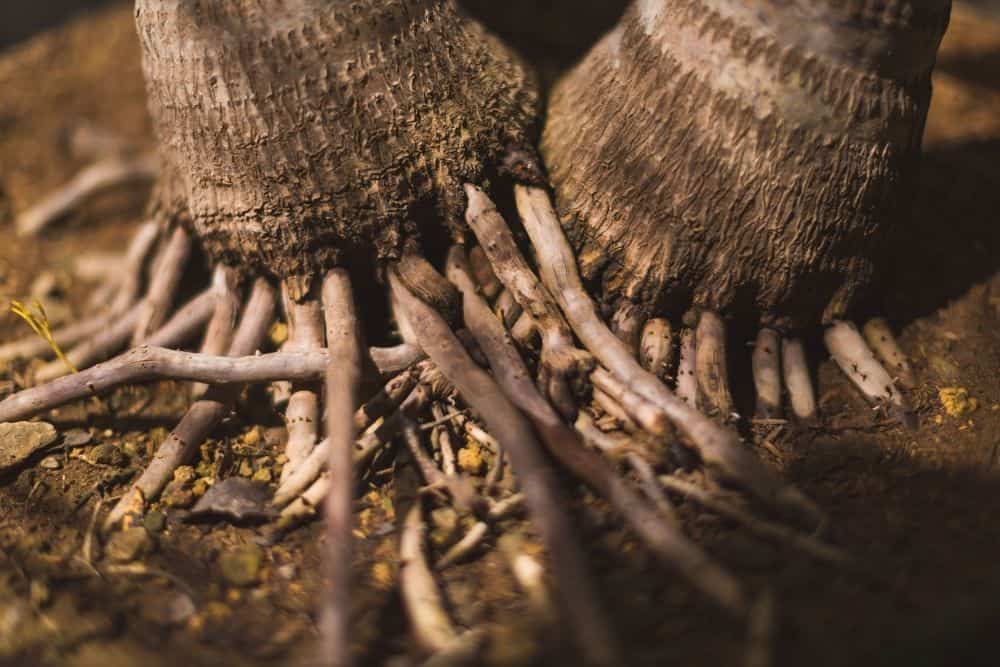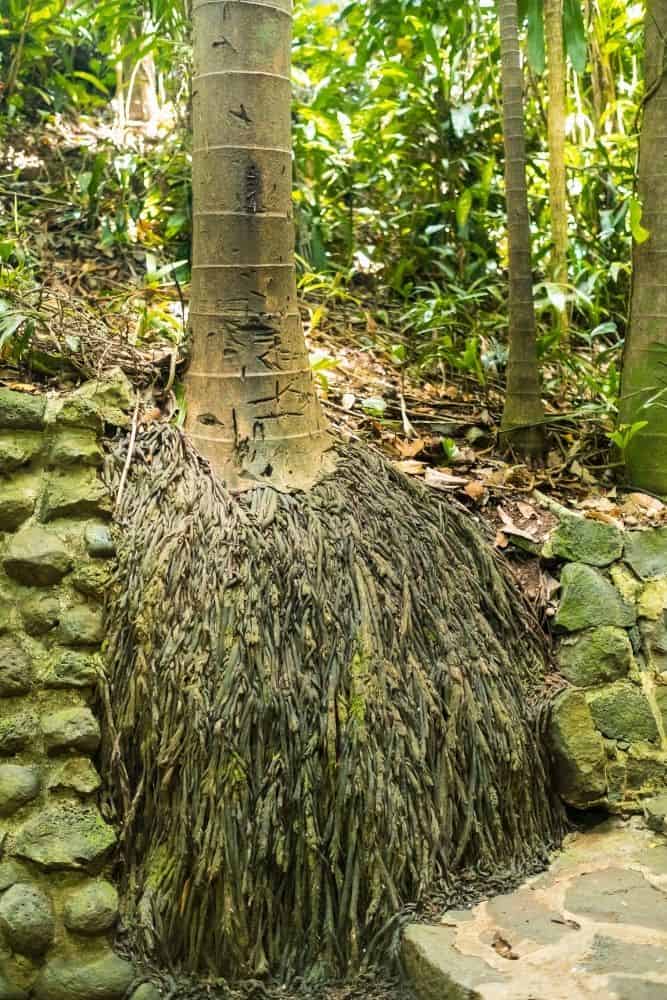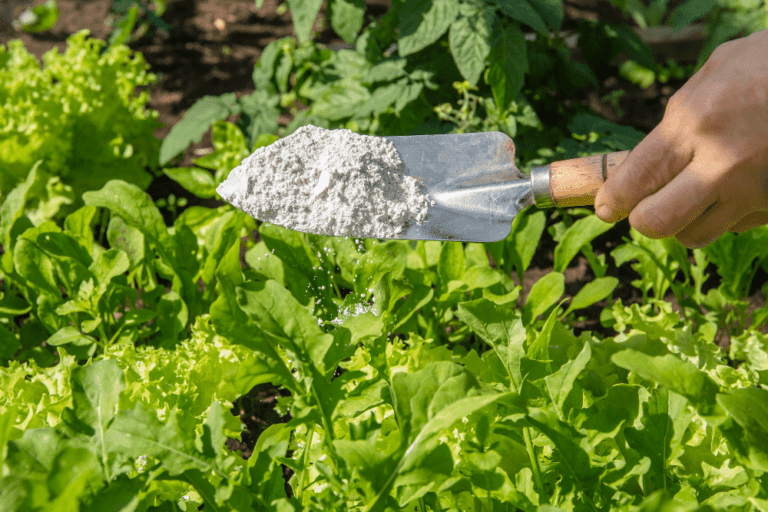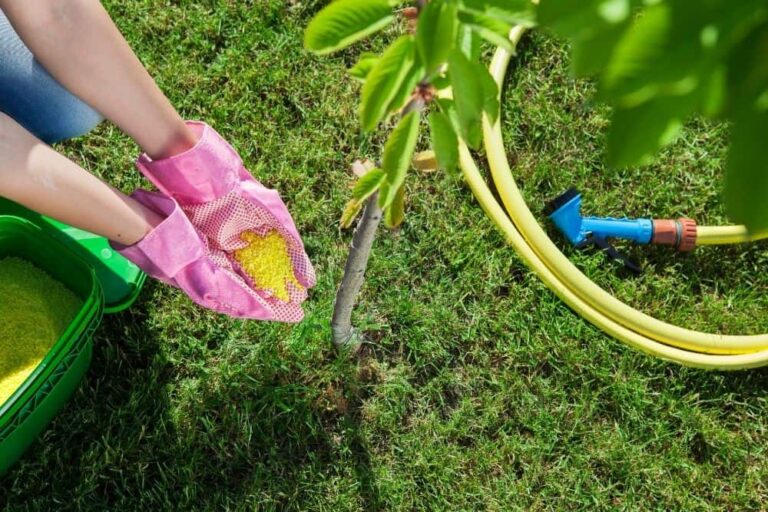Palm Tree Roots – How Deep Do They Grow? [Facts]
Palm trees are one of the more iconic tree breeds you can find. With their towering trunks, a sweeping crown of long leaves, and sometimes a cluster of coconuts attached to them, it’s hard to mistake them for anything else.
They are found in some of the warmest and most luxurious places on Earth, like California and Hawaii, though palms are a large family that can be seen all over the world.
What you don’t see, however, is their roots. Where most trees might fray at the bottom, showing their roots at the surface, palm trees look quite different. What anchors these narrow trees to the spot, in places where they are often hit by hurricanes and strong waves?
That’s what we’re going to find out today, by learning all about the root systems of palm trees and how deep they penetrate the ground.
The Palm Tree Root System
Let’s start with a general description of the palm tree root system, so we know what we’re dealing with.
First, you should know that they have a fibrous root system made from many, many tiny roots. For those of you looking for a quick answer to how deep they grow – about 36 inches.
If that doesn’t sound like much, that’s because it isn’t. For a family of trees that grow as tall as palms, a 36-inch root system isn’t that deep.
Even as the plant moves from adolescence to adulthood, the roots stay the same size. They coalesce into a ball of roots that help anchor the tree into the ground.
Often, a few of those thin, fibrous roots can be visible from the surface.
Unlike many other plants, palm trees don’t grow a taproot.
Taproots, if you didn’t know, are thicker, central roots from which smaller roots grow. Think of it as the ‘trunk’ of a root system.
They don’t exist in palm trees, instead hundreds of tiny roots emerge from the initiation zone and spread horizontally, again across 36 inches of the topsoil.
Some of these roots will die off as the tree grows. This is natural and more roots will take their place to continue feeding and anchoring the palm tree into the earth.
They are adventitious roots too, which means that they form directly from the stem and can grow in response to stress conditions, perfect for the tropical climates where palm trees commonly grow.
How Palm Tree Roots Grow

Palm trees are also one of the fastest-growing trees out there. These plants can grow up to 10 inches a year if they are in a supportive environment and aren’t disturbed by people or natural disasters.
As we said, even if they are disturbed, their root system is incredibly adaptive to interruptions.
Like any other tree’s roots, the roots of a palm tree grow to seek out water and other nutrients.
The most beneficial nutrients to palms are amongst the topsoil, which is why the roots don’t penetrate into the ground as much as you would expect.
Once enough of those fibrous roots have gathered, they will inevitably grow around each other and form a ball of roots.
From that ball, the roots will spread horizontally to seek out more resources for the plant.
The Ideal Soil
Most palm trees sprout and thrive in soil that is loose, moist and drains well, so it doesn’t retain water so much.
This includes sandy soil, too. This makes sense when palm trees are often associated with beachsides and other places where water access is abundant.
If the soil didn’t drain well, the palm trees would become overwhelmed and drown.
If the soil was compacted and harder, those thin roots would have a harder time establishing themselves and finding the right nutrients to support healthy growth.
The Root Ball
Palm trees establish root balls quite early into their life cycles. They need to, it provides early protection from harsh winds and other forces that would otherwise tear the trees right out of the ground.
If you need to shift a palm tree, you can use the size of the plant’s root ball to determine the size of its destination hole.
This is a handy indicator that you don’t get with other tree species, so transplanting palm trees is quite easy.
Any hole that is receiving a palm tree should be twice the size of its root ball, where it can then continue growing outwards into the surrounding oil.
Even smaller, indoor palm trees develop root balls that need to be considered when housing the plant.
For example, it’s common for areca palms to grow a root ball that becomes too tight within their pot, which then causes its leaves to grow with an unsatisfying brown color.
It also slows down growth and puts the plant at a disadvantage in other respects, too.
Root Depth
While we have established that palm tree roots can extend 36 inches into the ground, this is a generalized figure.
In reality, many palm trees will have their roots extend anywhere from 24 to 36 inches into the ground, depending on the exact species and how it has developed.
At their tallest, palm trees are capable of growing up to 75 to 100 feet, so just having a few inches of roots is very impressive.
There are smaller palm tree plants too, like interior palms that are about 3 feet tall, where the root system is more proportional to their size.
Planting Distance
As we have discussed, the roots of a palm tree will establish themselves into a ball and then start growing horizontally to find more nutrients. This can cause a problem if neighboring palm trees start to poach each other’s nutrients.
That’s why palm trees grow best when they are approximately 12 feet apart. That is ample room for them to grow, establish their roots, and then spread out to facilitate further growth, all without interfering with the neighboring plants.
They should also be planted away from underground fixtures like ground pipes. While small, those fibrous roots grow persistently and can cause damage to man-made infrastructure housed underground.
Exposed Roots
Where the roots sprout from the bottom of a palm tree’s stem, they may be visible at the surface.
Having exposed roots isn’t a problem for palm trees. First, they are inactive, because the real roots that are still in use are deeper underground.
Second, they are tough, adventitious roots anyway, so they’d survive even if they were in use and exposed to the elements.
Exposed roots are common for palm trees that have developed naturally with no human intervention.
When a climate is drier, you’ll typically find more exposed roots at the bottom of naturally occurring palm tree plants.
Are Palm Tree Roots Destructive?

While shallow, palm tree roots form formidable balls that aren’t to be underestimated. Let’s talk more about how palm tree roots interact with man-made fixtures.
The potential damage they can cause depends on the variety of palm trees you have.
For many, the roots stay a consistent diameter and pose no threat to installations like pipes or concrete.
Those thin roots won’t be able to penetrate and crack cement, as roots with an expanding diameter over time would.
With that said, root balls in some species like queen palms can become so compact and powerful that they displace pipes around them. Instead of penetrating and directly damaging the pipes, they warp the earth around them.
Then the pipes themselves are disturbed and can get damaged by bends and cracks.
How To Remove Palm Tree Roots
Since palm tree roots can sometimes cause problems, you may want to remove them.
Many people have palm trees in their gardens that can interfere with drainage systems, sprinklers, or even the foundations of your home.
Dealing with the roots is a necessary part of transplanting the tree from one location to another. When removal is necessary, you need to do it correctly.
To effectively remove a palm tree by disconnecting the roots, you need to get a shovel and dig around the tree.
You should do this in a radius of approximately 25 to 30 inches, so you can cut off any roots without causing much damage to the tree.
You may need to have an axe to cut lingering roots that extend beyond the radius that you have dug.
Roots that are left can grow back, so you should treat the hole with a herbicide that is powerful enough to kill the palm tree. By killing the palm tree, you’ll stop it from growing back.
Fortunately, you should be able to find many products out there that can deal with palm trees and the roots they send out.
That said, some species of palm tree won’t be able to grow back after the trunk has been chopped.
You should do some research into the exact type of palm tree you’re dealing with to figure out if you need to break out the herbicide or not.
Some types will re-grow if you leave some of the root systems behind, creating new stems that can eventually become their own stems and later their own trunks, too.
Fortunately, palm trees that can grow back are in the minority, so hopefully, they aren’t the type that is troubling you and your backyard.
To ethically cut down a palm tree, you should make sure you use any fruit attached to it and find something to do with the wood, too.
Most felled palm trees aren’t coming back, so you should make use of the natural resources they have provided for you.
Lastly, you should know that you might be able to keep your palm tree alive.
If you like the tree, you can prune its roots so that they are still functional but don’t grow beyond the root ball. This keeps the palm tree alive and controlled.
The only downside here is that the tree may be weaker to wind damage since they have less of a root anchor.




![Best Walk Behind Wheeled String Trimmer Reviews [year]](https://properlyrooted.com/wp-content/uploads/2022/10/Best-Walk-Behind-Wheeled-String-Trimmer-Reviews-150x150-1.png)

